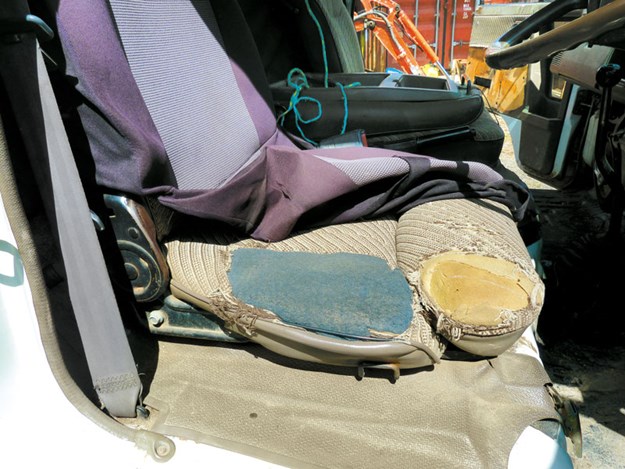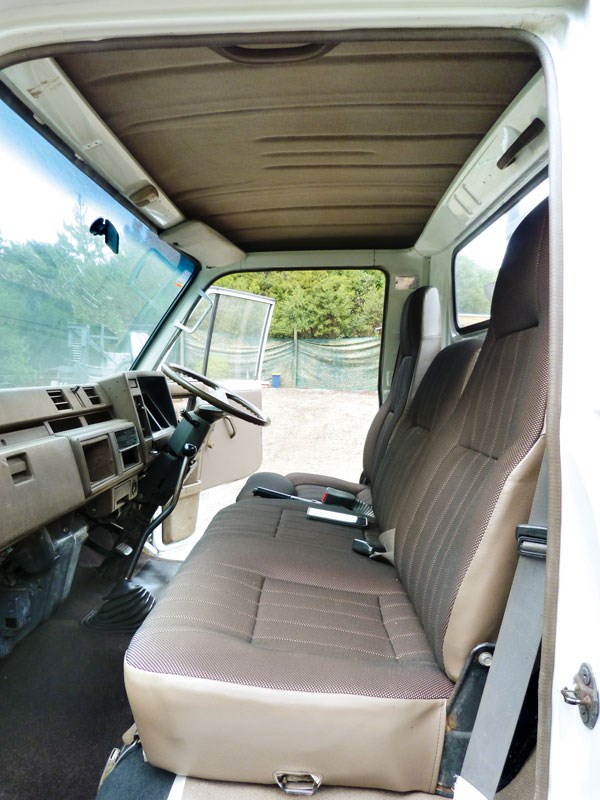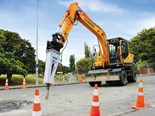Buying old gear? Read this
Is it worth buying pre-loved machinery? Deals on Wheels' Lyndsay Whittle shares his experience.
.jpg) |
|
A tip truck, two brand-new ramps, a digger, and four attachments were all part of the purchase
|
For a year or two, I’d been playing with the idea of buying a small excavator for my personal use, so during Christmas of 2018, having run the idea past the finance department (AKA my wife Christine), I decided to get serious about looking for one.
I had two basic reasons for giving a modicum of justification to the requirement (well, three really, if you throw in having just one more toy to add to the collection) given that over the years I’ve spent a small fortune on machine hire.
As part of my ‘business plan’, I was able to cite the actual time that’s wasted with the travel involved in collection and delivering machines back to the hire company it came from.
I figured out that when the aforementioned travel time was added to the better part of an hour to water blast the machine (depending on how messy the job had been), I’d typically be paying for nearly a day’s hireage simply for having a cute little machine in my possession that wasn’t actually doing any work.
The other reasons for wanting a machine of my own were focused around our bush-clad property in Auckland’s Waitakere Ranges where we have a small network of tracks and gardens that are in constant need of mulch, SAP 20 scoria, and crushed shell that’s always disappearing into the ground or being washed down the hillside during frequent rainstorms.
Also, the property where I keep my collection of old trucks requires periodic topping-up with the AP40 and AP20 crushed aggregate I use on the hardstand, particularly in winter.
The search begins…
Having my own four-tonne payload transporter, my initial search started out as a machine-only mission. I’d reckoned that the right fit size-wise for my requirements was a machine in the 1.8- to 2.5-tonne range.
Okay, I could have argued that the size of the area I need to roughly level-out for the trucks’ hardstand would be better suited to a much larger machine, however, I felt I couldn’t justify buying anything larger.
Besides which, even a smaller machine would get minimal use on my property at home due to the steepness of the site. Around the time of my search, the pickings were particularly slim in the range of excavator I was looking for, at least that was the case in the second-hand market.
I was, of course, aware of the two schools of thought as to buying new vs purchasing used equipment. However, my personal point of view is that there’s no right or wrong answer; it’s all a matter of the circumstances surrounding the purchase.
And in my case, it was that I wasn’t looking for a machine that was going to be used hard-out every day of the week, so that shoved the ‘buy new’ option off the table right at the outset.
I wasn’t particularly hung up on wanting any particular brand of excavator, as I have tested quite a few different makes and models for Deals on Wheels over the past few years and from those experiences, I knew that I’d be happy to own a machine of any brand that happened to come my way.
There were a couple of Takeuchi machines for sale in the South Island, and while that isn’t one of the brands I’ve tested, I’ve had good reports from people who’ve owned or operated them. The problem was the distance—South Island is a long way for me to go and have a look at something I may not end up buying.
… and stops at a 1-8-tonne digger and tip truck
 |
|
Delivering a load of crushed concrete AP40
|
After a month or two of looking, I came across a 1.8-tonne Komatsu that looked like it’d done a bit of work and looked to be cosmetically in need of some TLC; well lots of it if I’m honest.
Two positives surrounded the possibility of my making a purchase, one being that it came with an equally cosmetically challenged 1993 Daihatsu Delta tip truck. I can already imagine eyebrows being raised at the thought of a Daihatsu Delta being a positive, but more about that later.
However, the real big plus was that the combo was able to be viewed at an address situated about a 10-minute drive from where I live. I took the short trip down the road to give both truck and digger the once-over and confirmed my initial assessment of the state of both machines as being desperately in need of some immediate attention.
 |
|
The driver’s seat gives an indication of what the rest of the cab was like
|
Nevertheless, after the usual price wrangling over the course of the next couple of days, I wound up being the proud owner of the matched set. My initial assessment of both truck and digger was made just before dark on an evening in which some heavy showers were approaching, so a quick start-up and a wiggle of the controls of both machines had to suffice as I was going to be out of town.
The following day, for about a week. I have to admit to being a little concerned that I might’ve made too hasty a decision in agreeing to the purchase, however, I reassured myself that during my half-hour assessment that I couldn’t see anything majorly wrong with either machine. I went on to console myself that if there were some things I’d missed, I’d most likely be able to fix them without costing myself too much money.
Cosmetic changes
.jpg) |
|
The blade is a bit battered and bent but it still does the job until I get around to mending it
|
When I finally collected both machines and gave them a jolly good water blast, I found that my initial brief assessment was pretty-much on the mark and that most of the things that required rectification were of a cosmetic nature.
The only exceptions to that comment was the digger’s blade, which looked like it’d had a few arguments with some rather large rocks and was bent out of shape to a larger extent than I’d at first thought. The GP bucket was worn thin in a couple of places and the pins were a little more worse for wear than I’d at first thought.
 |
|
The digger’s cabin is next in line for a freshen-up
|
Having said that, to date, I haven’t done anything to remedy any of these items, even though the machine has moved somewhere in the vicinity of a couple of hundred tonnes of crushed concrete, basecourse, and scoria, with quite a bit of dirt and digging thrown in for good measure.
Naturally, I treated both truck and digger to oil changes, filters, etc. before putting them to work. But other than a few cosmetics on the truck, things such as tidying up the interior (something that was rightfully requested by the guys at VTNZ) and fitting a left-hand step that had been unmercifully torn off under its previous ownership, I haven’t gotten around to doing much else.
I spent a week cleaning and removing months of caked-on gunk when I first got the machines safely ensconced in their new under-cover environment. This effort was essential in getting at all the greasing points.
At first, I found the machine to track more quickly to the right than to the left, and I assumed it was simply going to be a fact of life, after all, I had bought a second-hand machine, not a new one.
One day while carrying out a service on the Komatsu, I discovered that one of the track rollers was a bit tight to turn and another was a bit wobbly. I found out that each roller was going to cost around $200 so I ordered two of the buggers.
I’d be surprised if the replacement job took me 20 minutes to complete and now the digger turns both ways at the same speed; it was the best investment in time and money I could’ve made, as it transformed the machine from a slightly tired old beast to something that felt a whole lot newer.
When I finally get around to replacing the worn pins, straightening out the blade, and giving it a fresh coat of paint, it’ll almost be like new again. If I don’t take my time into account (I enjoy the mechanical and light engineering side anyway), I reckon I’ll get away with an extra couple of thousand bucks to buy materials and have work done that’s outside of my scope of ability, and let me tell you, a lot of things are.
All in all, I’ve been able to set myself up with a workable little truck and machine operation for less than $20k. Ironically, it’s been the battered and bruised Daihatsu Delta that has inadvertently allowed me to claw back just a little of my initial investment.
During the course of collecting a number of 2.5-tonne loads of the crushed concrete, people have seen what I’ve been doing and asked me if I could get some for their projects.
Who knows, I might wind up getting my money back from a venture that was initially designed for my own use.
 |
|
The interior is now probably prettier than it needs to be
|
It’s fair to say that the Daihatsu isn’t the most powerful truck on the road, but it has a great hoist and a good tipping angle. The lack of power hasn’t proven to be a problem to date, as most of my travels usually amount to 20km round trips.
The attached photos will show that perhaps I’ve spent a little more on the truck’s interior than the vehicle deserves, however it does make it quieter and more pleasant to drive. Well, the long and short of it all is that it can be worth considering buying equipment that’s a little run-down, that is if you have the space in which to work on the gear and even just a smidgeon of the ability to do some of the work yourself.
It certainly worked for me.
Deals on Wheels has thousands of new or second-hand gear for sale in NZ
Keep up to date in the industry by signing up to Deals on Wheels' free newsletter or liking us on Facebook.


.jpg)




.jpg)


.jpg)

.jpg)
.jpg)
.jpg)
.jpg)

